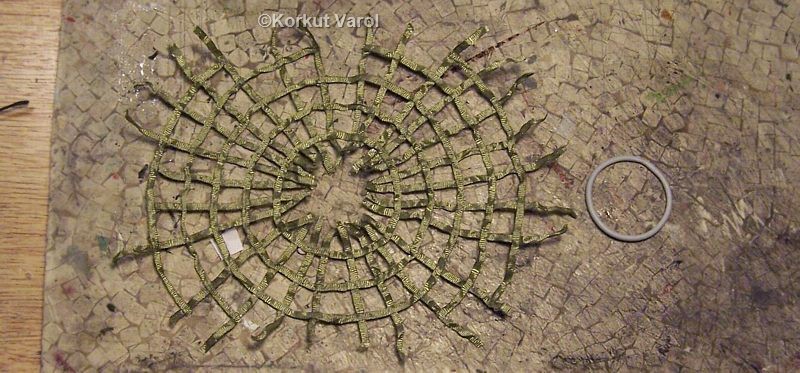| The Lynx
ProjectLincoln-Mercury’s Lost Dream Car |
 |
  |
|
BUILDING THE DC-8 PLANE
Page: 4 of 11
05 January 2014:I finished installing the cargo and passenger door peripheral profiles.
10 January 2014:
I
made a bending male+female die set for the H-profile, squeezed the
profile in between and set the shape by heating the squeezed profile
with a heat gun. Then I cut the necessary notches to fit the fuselage.
I began manufacturing the cylindrical rollers that the cargo net will
be installed on.
I glued the rollers inside the profile.
The photo below shows finished rollers inside right and left profiles.
I cut and shaped the passenger door outer panel from brass sheet.

11 January 2014:
I painted the rollers chrome silver and the roller brackets dark iron.
12 January 2014:
I glued the left and right parts in the fuselage with epoxy glue.

| Now to manufacture a deck net, something like this: |  |
I
drew a net layout on the computer, taking into consideration, the
sagging lengths. My first attempt was to cut from paper and try to give
a shape. I cut the radial and peripheral lines separately, and glued
the peripherals over the radials.
I tried a demo on a piece of plywood, but I did not like the paper contours, despite that I had softened the paper with steam.
14 January 2014:
I
changed the work material to ribbon. I began by cutting and laying the
strips, but noticed that the ribbon was also too inert to be shaped to
crimpled looks, so I stopped and started again.
15 January 2014:
I pre-crimpled the stripes before laying on the template. I did the radials first.
16 January 2014:
I glued the peripheral stripes over the radials and unpinned the net after drying.
I made the central circle from copper wire,
then I installed the circle in the net. I airbrushed the net with flat grey to suppress the brightness of the ribbon.
24 January 2014:
I painted the deck floor flat grey, masking the places that the rollers will be; for better adhesion.
02 February 2014:
A
new task: To hold the cargo door in open position. Although the
door will incorporate the hydraulic cylinder mechanism, this is just a
dummy for appearance and will not hold the door firmly in air. So I
thought of some other means that will be invisible when completed. I
cut strips of brass sheet and soldered them on the door skeleton.
I scratched channels in the plastic door frame to house the brass strips.

I
bent the brass strips so that the door will be held in proper angle.
This is a removeble fixture and will provide ease while working. This
will be fixed just before the outer skin is covered over the fuselage.



























